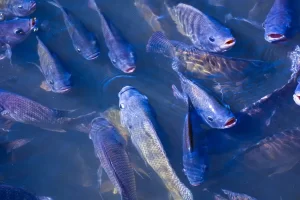Fish farming in Zimbabwe has gained ground in the last ten years, making it one of the top ten fish farming countries in Sub-Saharan Africa. Many new farmers are embracing fish farming as their contribution to food security in Zimbabwe, as fish is a rich source of protein and essential nutrients.
Species of Fish Reared in Zimbabwe
The main fish species reared commercially are:
a) Nile Tilapia (Oreochromis niloticus)
- The Nile Tilapia constitutes 90% of the fish reared in Zimbabwe. The main source of this fish is Lake Kariba, a lake situated on the border of Zambia and Zimbabwe.
- This species is popular with fish farmers because it grows quickly and is resilient.
b) Rainbow Trout (Oncorhynchus mykiss)
- The Rainbow Trout is an African freshwater fish reared in Nyanga, located in the Manicaland province of Zimbabweclose to the Mozambique border.
- It is the second most popular species reared in Zimbabwe.
c) Sharptooth African Catfish (Clarias gariepinus)
- The African Catfish is another popular fish species, due to its resilience and fast maturity. It is also not affected by conditions where the water is of low quality.
- This fish can also be reared in tanks or cages.
Other species of fish reared in Zimbabwe are the Red-breasted Bream and the Mozambique Bream.
Location of fish farms in Zimbabwe
- Fish farming in Zimbabwe is carried out on industrial, commercial, and subsistence levels.
- Lake Harvest Aquaculture in Lake Kariba produces the largest amount of fish in the country. This intensive vertically integrated fish farm is the largest freshwater fish farm in Africa.

Ideal temperatures for rearing fish
- The ideal temperature for rearing commercial Nile tilapia ranges from 27 to 32°C, making the Lake Kariba area ideal for fish farming.
- Rainbow trout do well in water temperatures ranging from 7 to 18°C. African catfish, however, thrive in water temperatures ranging from 25–30°C.
Feeding Practices
- Fish reared in ponds must be fed so that they can attain maximum growth, as plankton is not sufficient to sustain their growth. Most farmers either use commercial fish feeds, locally available ingredients, or a combination of both.
- Commercial (formulated) fish food pellets are designed for specific fish species like tilapia or catfish. These feeds are rich in proteins and nutrients that promote optimal growth.
- Some of the local ingredients that farmers feed their fish on include cotton seed cake, sunflower cake, wheat bran, rice bran, maize bran, millet, and cassava flour.
Demand for Fish Products in Zimbabwe
- There is a huge market for local fish products in Zimbabwe. Tilapia are processed into fillets that are available in supermarkets and butcheries. The by-products (heads, belly flaps) are then sold to low-end consumers.
- The Rainbow Trout is less popular and more expensive than tilapia. It is available in high-end supermarkets and restaurants. Trout is sold as fillets, smoked whole trout, trout patties, and frozen whole trout.
Challenges facing fish farming in Zimbabwe
The challenges facing the fish farming industry include:
- Access to finance for setup and expansion.
- Increased need for technical knowledge and training to enhance yields through efficient feeding, water quality management, and disease control.
- Unsustainable practices, including overstocking and poor waste management, which contribute to water pollution and habitat destruction.
- Implementation and enforcement of regulations to promote environmentally responsible fish farming
- Establishment and enforcement of regulations to encourage environmentally sustainable fish farming.
Fish farming in Zimbabwe is a promising industry that will result in improved food security, job creation, and a boost to Zimbabwe’s economy.

Comments